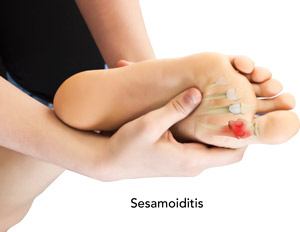Sesamoiditis

What is Sesamoiditis?
Sesamoiditis is the inflammation of the sesamoid bone and its associated tendons. It is commonly seen in ballet dancers, sprinters and basketball players, and is an overuse injury caused by increased pressure over the sesamoid bones.
Sesamoid Anatomy
Sesamoids are special types of bones found in the knee, wrist and base of the big toe. Unlike other bones of the body, these do not articulate with other bones, but are embedded within tendons, providing a smooth surface over which the tendons can glide. Two small sesamoid bones are found on the underside of the big toe.
Causes of Sesamoiditis
Trauma or injury to the sesamoid bone and surrounding soft tissues is the most common cause of sesamoiditis. Injury can include muscle pull, ligament sprain, fracture or dislocation of the neighboring joints. Repetitive stress or chronic overuse can result in a stress fracture of the sesamoid bone, which can be a cause of persistent pain. Sometimes a condition called osteonecrosis, a lack of blood supply to the bone, can result in the inflammation of the sesamoid bone. Frequent use of high heeled shoes can aggravate the condition.
Symptoms of Sesamoiditis
A dull, longstanding pain is the predominant symptom of sesamoiditis. The pain usually develops gradually, but in case of a fracture, the onset is sudden. Pain is aggravated with movement and pressure over it. In some cases, swelling and bruising may also be present.
Diagnosis of Sesamoiditis
A thorough physical examination is essential for the diagnosis of sesamoiditis. Your physician will check for tenderness and aggravation of pain on movement, which helps evaluate the type and cause of the injury. X-rays may be ordered to confirm the diagnosis. In case an X-ray is inconclusive, your physician may order a bone scan.
Treatment Options for Sesamoiditis
The treatment of sesamoiditis is usually non-surgical. In very rare cases, surgery is considered when non-surgical approaches fail to provide any relief. Non-surgical treatment options include:
- Immobilization: Take adequate rest and avoid activities that cause pain. Your foot may be placed in a removable cast, and crutches ordered to avoid bearing weight on the affected bone.
- Padding and strapping: A pad may be used to cushion the inflamed area. Strapping can be used to relieve muscle tension around the inflammation.
- Physical therapy: Range-of-motion and strengthening exercises may be advised. Ultrasound therapy can also be helpful in relieving pain.
- Orthotic devices: Some orthotic devices such as special shoes that cushion the injured area can relieve the pressure over the affected sesamoid.
- Oral medications: Nonsteroidal anti-inflammatory (NSAIDs) medications may be prescribed to reduce pain and inflammation.
- Steroid injection: Sometimes a steroid injection may be administered to reduce pain.
Prevention of Sesamoiditis
A recurrence of sesamoiditis can be prevented by following a few simple measures:
- Wear appropriate shoes with proper padding.
- Follow physical therapy to improve gait and strength.
- Avoid high heeled shoes and other activities that would aggravate pain.



